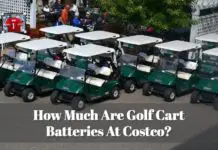
Golf carts or caddies are electric-powered vehicles that run solely through electricity. Batteries power these E-vehicles with deep cycle capabilities similar to regular deep-cycle cells and marine batteries. With that said, golf carts are considered as battery-operated vehicles equipped with smaller deep cycle power cells.
Marine batteries and golf cart power cells both feature solid and thicker battery plates made from lead. This allows these batteries to tolerate repetitive discharge that can go up to 80% of their full capacity. Due to this deep cycle ability, the issue of regular deep cycle power cells can be used in golf carts has been raised.
Can I use regular deep cycle batteries in my golf cart? Technically, YES! Using a regular deep cycle battery or a marine battery on a golf cart is technically and logically possible. As long as the battery is designed for deep-cycle applications and able to meet the power requirements of the golf cart, it will just fine.
However, you must keep in mind that the similarity between the batteries does not suggest or mean they are interchangeable. You have to understand that battery manufacturers classify the cells they produce according to applications. That is why specific cells are specially designed for boats, cars, golf carts, etc.
Using a regular deep cycle power cell on a golf cart will also significantly impact various aspects like the golf cart’s performance, runtime, and service life. It may also lead to several damages in the vehicle’s system, especially the sensitive parts and components.
You also have to remember that regular deep cycle batteries are still different from golf cart batteries, and they are different in a lot of things. That is why, the answer is yes, a regular deep cycle cell can be used on a golf cart, but it is not recommended.
The fact that you are here reading this article clearly shows that you are confused about a golf cart, marine, and regular deep cycle batteries. Perhaps you own a caddie that needs a replacement cell and figuring out if you can use your deep cycle batteries or are probably looking to get a replacement for your golf cart power cells.
I know that you already got the confirmation you are looking for, but I am inviting you to stay for a while and learn more about these batteries.
How Regular Deep Cycle Cells Different from Golf Cart Cells?
To be able to understand what beyond the answer that I provided above, I think it will best if you know how a regular deep cycle cell is different from a golf cart battery.
As I mentioned earlier, they are similar because of their deep cycle capabilities, but the nature of these batteries are not the same. Yes, they both feature thicker plates and can be run down until they have 20% left within them, but that’s where the similarity between them ends. Let’s take a look at their differences.
The noticeable difference between them is that they are built for different scales, where the golf cart cells are on a smaller scale compared to the regular deep-cycle cells. To better understand these differences, let me show you them to you one by one.
1. The Specific Nature of Both Batteries
You have to understand that golf cart batteries have a different nature than regular deep cycle batteries. Golf cart batteries come in three types classified according to their voltage rating; they may come on a six-volt variety, an eight-volt variety, or a twelve-volt variety.
These batteries are specifically designed for ATVs and caddies, and they don’t have the kind of charge a regular deep cycle power cell has.
On the other hand, a regular deep cycle battery is built for deep discharge applications or usage, which means that it is designed to be discharged for long periods of time and be recharged a lot of times.
However, this is on a larger scale that makes it different from the golf cart cell. With that being said, a regular deep cycle power is ideal for boats and trolling motors.
2. Capacity and Amperage Output
Another significant difference between a regular a deep cycle battery and a golf cart battery is their capacity and the amperage output they can deliver. Regardless of voltage rating, a golf cart battery has a cell structure where each of its cells has a slightly different output. This is the amount of power each of its cells delivers when used in a cart.
A regular deep cycle battery has a different cell structure because it has an equal output for every cell. Typically it has a usual capacity rated at eighty (80) Ah with a maximum current output measuring at around five-hundred (500) amperes.
The typical current output of a golf cart battery usually ranges from six-hundred (600) to one-thousand eight-hundred (1800) amperes, depending on the cart’s configuration.
If you take a closer look at the output, you will notice that the golf cart battery has a higher output rating. This is where the confusion usually comes in. You will arguably say that golf cart power cells are more robust since they generate more amperes.
However, it doesn’t prove that they are suitable for trolling or boating applications because golf cart motors have a different amperage requirement than trolling motors.
3. Operating Temperature Range
Temperature is also a concern when we talk about the differences between the golf cart and regular deep cycle batteries. A twelve-volt deep cycle battery has a lower charging temperature range compared to a twelve-volt golf cart cell.
Experts say that a regular deep cycle battery is rarely charged at a temperature higher than 90 degrees Fahrenheit. In contrast, golf cart power cells are usually charged at this temperature level and even higher.
4. Proper Way of Charging the Batteries
As mentioned earlier on the previous item, the operating temperature range has a direct impact on the charging process, which is why it leads to this next difference, the proper way of charging the two batteries. The appropriate method of charging a regular deep cycle battery is different from the right way of charging a golf cart battery.
Regular deep cycle power cells should be regularly charged even they are not used long periods of time. These batteries are also designed to be recharged when used, and any kind of charger can be used.
Deep cycle power cells are also recommended to be charged with a trickle charger, making it ready to use as always. With this kind of charging, it also keeps it from being sulfated.
On the other hand, the proper way of charging depends on the type of battery. If it is a lead-acid golf cart cell, it must be regularly charged and required to be charged on an area with good ventilation. This is because it has a normal charging temperature range close to room temperature. It will also require a regular refill of electrolyte.
In case the golf cart battery has lithium-based chemistry, the battery has to be charged with an ambient temperature that is relatively moderate. It can be charged while on the cart, provided that the cart is turned off, except if it will be stored for a long time.
Its proper charging also needs to disconnect the charger after reaching full capacity, since lithium battery chemistries are not designed to take overcharging.
Those are the differences between a deep cycle power cell and a golf cart battery that you have to keep in mind. Although they have a few similar features and it is possible to run caddie with a regular deep cycle battery.
The list of differences clearly shows that they are not the same and interchangeable. These are also the main reasons why it is not recommended to use a deep cycle battery on golf carts.
Lithium-Based Chemistry’s Impact on Deep Cycle Batteries
One of the most revolutionary milestones that shook the battery manufacturing industry is the time when the lithium-based battery chemistry materialized. It was a breakthrough that significantly impacted the companies that specialize in producing batteries with deep cycling capabilities.
Most of them focused on producing products with the new chemistry, while a few of them, most of the established names, dared to stick to what they do and continued with the lead-acid chemistry.
Due to its nature of having deep cycling capabilities, all lithium-based batteries are considered a deep cycle. This fact eliminates the various classifications on batteries with the same chemistry.
Unlike the lead-acid battery chemistry, manufacturers produce cells for specific classifications like a deep cycle, marine, and starting batteries. Lithium-ion batteries are produced as marine or starting batteries that are also suited for deep cycling applications.
This is the distinct innovation that lithium-based battery chemistry staggered the golf cart battery industry. Since all lithium cells are also deep cycle cells, a prominent and formidable competitor emerged in the specific golf cart battery market represented by more powerful lithium-based golf cart cells.
This made the market more competitive and fiercer as manufacturers that stuck with the lead-acid chemistry are forced to produce batteries that can keep up with the new titans.
Lithium-Ion and Lead-Acid Golf Cart Batteries: Deep Cycle Comparison
Earlier, I mentioned that lithium cells are capable of surpassing the specifications of lead-acid cells. However, because the market for golf cart batteries has become too competitive, it gave way to enhanced and improved lead-acid batteries offering better deep cycling capabilities.
Due to the higher cost of production of lithium cells for golf carts also allowed the existence of the old ones, the proven and tested golf cart batteries that have been used for years.
The use of lithium-based batteries in golf carts has been a prospect that offers a lot of great benefits. But there’s a catch, most old model caddies are designed to use the lead-acid type of battery and wouldn’t run just by swapping the lead-acid units with the newer lithium cells. It’s don’t work that way.
To use these lithium cells on golf carts, a retro-fit kit is needed for these E-vehicles to bridge the compatibility issue.
Suppose the swapping of batteries was successful. It will have a significant impact on the cart’s performance, and all of them will be noticeable on the way the cart works. Here are the major improvements that will take effect on the cart’s deep cycle battery.
Significant Increase in Weight Capacity
Since lithium-ion batteries are deep cycle cells with a higher energy density, they are usually smaller in size or lighter in weight. Switching a golf cart system from lead-acid to lithium will significantly reduce the cart’s weight allowing it to carry more. This will be noticeable since golf carts supported by a lithium battery will carry two additional adults.
Charging Speed and Battery Cycle
Lithium-ion batteries for golf carts are engineered to have more charging cycles that give them better longevity than their lead-acid counterparts. Additionally, lithium cell technology charges a lot faster, making it more desirable for electric-powered vehicles.
Equipping a cart with a lithium battery will make it always ready to use since charging its battery will only take a short time.
Low Upkeep Requirements
Switching a cart’s battery from lead-acid to lithium-ion will be more convenient since it is designed to be maintenance-free. The lithium battery technology does not use a liquid electrolyte, so it doesn’t need to be checked and refilled.
All you have to keep in mind about it is that you should not drain it below 20% and avoid overcharging it, which can be easily addressed using a smart charger.





